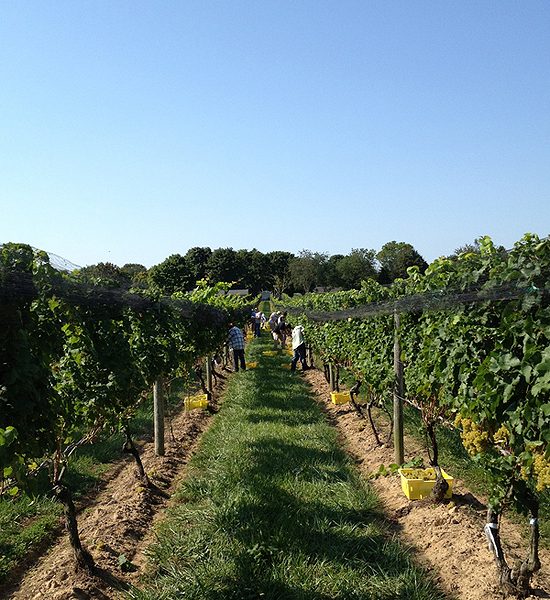
From mid-August to early November, Long Island’s vintners live on tenterhooks: will the ripening grapevines, after a year of loving care, bring their crops to perfect ripeness, or will Mother Nature force a premature harvest with an angry flock of birds, infestations of mildew ignoble “sour” rot, or a lashing hurricane?
Until all the grapes are safely burbling in vats, it is too soon to say what the quality of the vintage will be.
Growers who are paid by the weight of grapes harvested per acre will urge winemakers to pick early so as to maximize the yield of sound fruit from healthy vines. But winemakers like to wait for the perfect moment—a moment that may never come if calamity intrudes. Even if the grower and winemaker work as a team, there will still be a push-me-pull-you relationship going on unless both have a perfect understanding of what risk level is acceptable to both.
This year, a warm summer on Long Island meant an early start to harvest, around Labor Day, with chardonnay and pinot noir chosen at the beginning of ripeness for high-acid, low-alcohol wines. The last grapes to be picked, presumably near Halloween, will be varieties such as cabernet sauvignon, merlot, and petit verdot, all needing full ripeness.
In every case, the decision to pick is based on the sugar content, acidity, pH, tannin and overall quality of the fruit. The range will vary in each parameter, depending on the style of wine and the nerves of the vintner.
From veraison (the onset of ripening), when the fruit changes color in midsummer, sugar increases as acidity decreases. The increase in sugar depends on sunlight; the decrease in acidity depends on temperature. For this reason, a sunny location with moderate temperatures will yield the most balanced wines.
Table wine needs at least 10-percent alcohol for stability, so, considering that the alcohol yield is about half of the sugar content of the must, the fruit should contain at least 20-percent sugar. If the fruit is insufficiently ripe, it may be “chaptalized” by addition of sugar (a process invented in 1801 by Napoleon’s chemist, Jean-Antoine-Claude Chaptal). In hot climates, excess sugar may be diluted by adding water.
Acids, usually in the range of 1.2 percent to 0.5 percent before fermentation, and .8 percent to .5 percent after, may also be adjusted. Malic acid (the same acid found in apples) can be reduced by addition of chalk, or by a secondary fermentation, as certain fastidious bacteria will convert it to lactic acid (the milk acid, which is half as sharp). Tartaric acid is more stable, but will decrease after fermentation when chilling precipitates its salt—potassium bitartrate—those little crystals often found on the corks of chilled wines.
Although you probably forgot about pH (the negative logarithm of hydrogen ion concentration) long ago, winemakers’ picking decision are often driven by the pH. This measure indicates how much the acids’ electric charge is buffered by minerals (especially potassium) that accumulate with ripening.
If you want to sound smart as a wine taster, just say, “This wine is soft on the palate, and its color is dull—it must have a high pH.”
Some winemakers like to pick for low pH; others want the fruit riper and will deal with a high pH by adjusting it with tartaric acid. This makes the wine more stable and fresher, but can give it a hard tang in the aftertaste.
In testing grapes for sugar, acid and pH, vintners need to gather a meaningful sample. It’s not enough to go into the vineyard, pick a nice looking berry and test it. Some winemakers leave the sampling to the vineyard crew, but most want to see the crop for themselves, and will regularly peruse every part of the vineyard in the days before harvest.
For red wines, tannin development is supremely important and all other considerations are irrelevant if the tannins are too harsh. This is why vintners want “hang time,” leaving fruit on the vine even after sufficient sugar accumulates, so that the bitter, astringent tannins can mellow.
When grapes are fully ripe, their seeds turn dusky brown and their skins shed color to the touch. By then, of course, natural acidity may be too low; sugar may be too high; pH may have soared; and Mother Nature may have destroyed the crop.
The more experienced a vintner is, the more harvest decisions are based on flavor, fruit condition and intuition. Scientific analysis is important, but leaves plenty of room for the winemaker’s art.